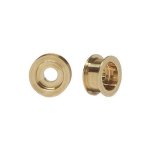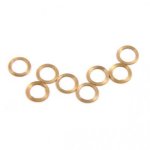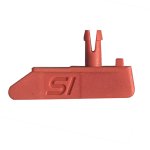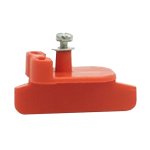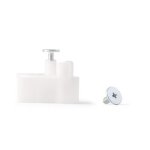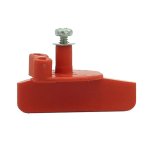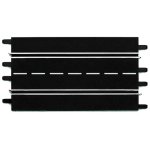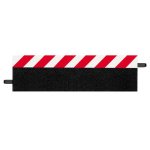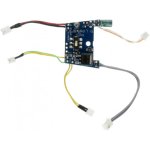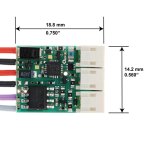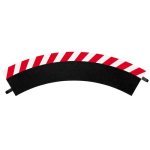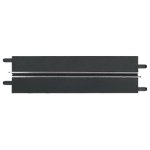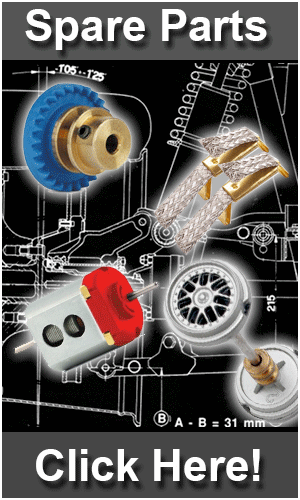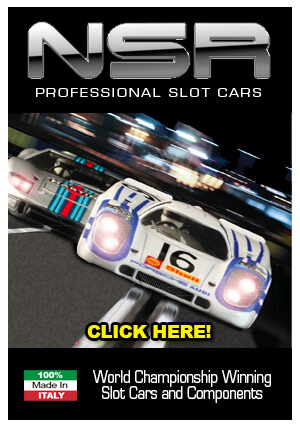A Triple Threat: Carrera Porsche 917K
Review by: Jeremy ‘bibbster’ Bibbee
What could be better than a Porsche 917K in 1/32 scale manufactured by Carrera? How about two Porsche 917Ks in 1/32 scale? How about three?! I’ll be reviewing all of the recently released Porsche 917Ks from Carrera which comes in two liveries; the Martini International Watkins Glen 6h, No. 35 (digital item# 30737) and the Martini International Kyalami 9h, No. 2 (digital item# 30736), the latter of which is also available in analog (item# 27498). I’ll take a look at all three of these cars, and though their mechanicals are the same, they all deserve a look especially if you like Porsches and slot car racing.
While the Porsche 917K has been produced by other slot car manufacturers, the releases from Carrera beat them all by a long shot. There is a lot of value and several features that make these cars shine. Hopefully I’ll be able to provide you with some information to help you decide which model(s) you will choose.
Before I go any further, I want to speak about the value aspect of Carrera slot cars for a moment. There are no other manufacturers that offer 1:32 scale slot cars at the price point that Carrera does. Period. While there are occasionally analog cars offered at similar prices, they usually have blacked out windows and no interior, among other things. Where is the fun in that? For approximately $32 USD, you get a very close representation of an actual car, interior, driver, and all. For about $12 more, you can get the digital version which comes with lights as well as the opportunity for you to change lanes, make pit stops, and various other features that come with digital racing. So overall, Carrera has the dollar, fun, value, and feature ratios set at a place where anybody can enjoy the hobby of slot car racing.
As I mentioned earlier, there are three models available from Carrera, which brings us to our first feature; digital and analog options. Whether you race digital or analog, Carrera has you covered in more than one way. If you are an analog racer, you can easily convert all Carrera digital cars to analog mode with the flip of a switch on the bottom of the car. After flipping the switch, put the car on the track and depress the controller throttle three times. The car is now in analog mode. Purchasing a digital car affords you to have lights in your car. Analog cars do not come with lights so if you like lights, go with the digital version(s).
The digital versions provide you with two liveries to choose from; the Martini International Watkins Glen 6h, No. 35 (digital item# 30737) and the Martini International Kyalami 9h, No. 2 (digital item# 30736). Both liveries look very nice and you may as well not settle on one. Go ahead and get them both, they are Porsches after all! Seriously though, each model is executed very well. The sponsor logos, text, numbers, and other graphics are all very crisp and the colors are vibrant. You can see just how nice these cars look in the various pictures throughout this review. So while other makers produce a detailed 917K, Carrera has upped their game over the years and provides a striking execution of this iconic race car that runs very well, as you’ll hear about later, for very little money.
The size of the car is very close to scale as well. While it isn’t spot on, the Carrera 917K is close enough that you won’t be able to tell, which makes it a very good representation of its full size counterpart. Here is the rundown on the measurements of the full size car and the slot car model.
|
1:1 - Length / Width / Height / Wheelbase |
4,120 mm / 1,980 mm / 940 mm / 2,300 mm |
|
1:32 (True scale) |
128.75 mm / 61.87 mm / 29.37 mm / 71.87 mm |
|
Carrera Model |
130.51 mm / 61.30 mm / 29.20 mm / 72.40 mm |
Here you will see the mechanicals of the cars. The pictures below allow you to see the digital chip which is required to run on the Carrera digital track system. As mentioned earlier, you can run digital cars on analog track with the chip in place. The gear ratio is 3.37:1, by way of an 8 tooth pinion and 27 tooth crown gear. While typical gearing in Carrera cars is 3:0 (9T pinion and 27T crown), this car utilizes a motor that allows it to be competitive with other cars using the standard gearing. The motor in the 917K is a FF-050 (slimline) and is rated at 25,000 rpm. The extra rpm’s allow it to keep up easily with other cars motored with the Carrera E-200, which is rated at 21,000 rpm.
Notice that the lights at the front of the car are each on separate circuit boards. With the slope at the front of the body, a single circuit board is not possible. While the full size 917K did have brake lights, the Carrera model does not. You can’t blame them though as the car doesn’t lend itself to the required wiring and such while keeping kids safety in check. For those like myself that may have an urge to add brake lights to this car, the rear light plug (orange/white wire) is present on the digital chip so wiring will be pretty straight forward.
Carrera has done a nice job on blocking out most of the residual light from the LED’s, but there is still some very minor bleed through. The most noticeable amount of escaping light comes from the underside of the car, which you can see in the photo below. It is more prevalent on the #35 car than the #2 car that I have. If it really bothers you, some strategically placed black paint and/or electrical tape will take care of it. Me? I’m gonna race ‘em!
The bottom of the chassis shows the item number, the dip switch to change the car from analog to digital and the IR sensor (located on the digital chip), as well as the guide and magnets (one located just forward of the rear wheels and one inside the chassis just below the item number).
Okay, so how do they run? When reviewing slot car I take them right out of the box and head to the track. On my way to the track, there are three things that I do; make sure the front and rear wheels spin freely, make sure the guide braid is adjusted so that it makes good contact with the track rails, and make sure the guide turns freely. Carrera cars come from the factory with a decent amount of lubrication on the gears and axles which usually suffices for testing. All Carrera cars come with an instruction sheet on maintaining your slot car. It is easy to skip reading it since it is in the back of the case and we’re usually anxious to get started with racing, but give the sheet a good once over and you’ll be set for future purchases as the procedures are the same for all of their cars.
All three cars ran very smooth on my custom routed wood track. Typically, if a car is smooth on that track, it will be smooth on my Carrera digital track. That held true with all three of these cars. I had a spare digital chip, which can be purchased separately for any analog car (item# 26732), so I put it in the analog car and tested it on my digital track as well. Lane changing functions worked well as did all the other functions of digital racing, including pit stops, lap counting, and so on. Again, analog cars do not come with lights which means no night racing for this particular model.
Grip from the tires on both tracks was good for two of the three cars. One rear tire on one car was significantly harder than the others. It reminded me of Carreras old tire compound from a couple years ago. The tires, while the did have some grip, would quickly begin to lose traction. Their newer tire compound is almost more of a urethane type as they are much softer and hold their grip for many more laps over the older versions. Aside from that one single tire, the cars performed very well in the tire department.
In less than fifty laps, on each track, the cars became very predictable making them easy to control. Speed out of turns was quick with very little tail-out action. Braking was smooth and crisp with the cars stopping in less than a foot from full throttle to zero on both wood and plastic track. I was able to drive deep into the turns and find the sweet spot for exiting quickly. Racing these cars is loads of fun!
In conclusion, this model definitely does not disappoint in the looks department or the fun department. As I mentioned before, you’ll be hard pressed to find this much fun in an affordable package in the slot car hobby. Adding this model to your collection, whether it is the first slot car you buy, or you have hundreds, is a must! So give this one a try, you won’t regret it!


